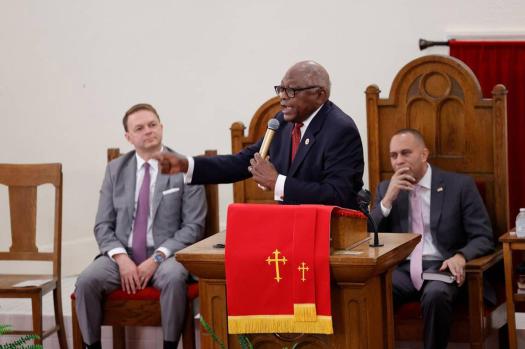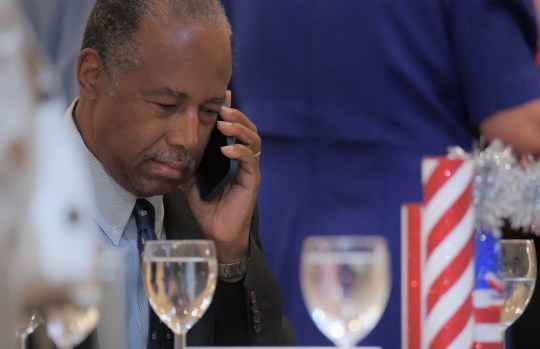
Gov. Wes Moore, in an energetic speech in which he promised to “reclaim the mantle of innovation” and trumpeted his administration’s achievements, said the revived Red Line transit project in Baltimore would be a light rail line — though he offered few specifics about how the state will pay for the costly vision.
The Democrat called light rail — as opposed to rapid bus lines, which also were considered — “the right and fair choice.”
Nearly a decade after then-Gov. Larry Hogan abruptly canceled plans for the original Red Line, Moore spoke to more than a hundred staffers and supporters wearing red as a few dozen red balloons waved in the wind in the parking lot at the Johns Hopkins Bayview Medical Center.
“We knew that bringing the Red Line back to life wasn’t just an opportunity. It was an obligation,” Moore said. “That we weren’t going to pass the ball, that we weren’t going to equivocate and we weren’t going to just hope that someone else would solve this problem for us.”
But in deciding on light rail, Moore also landed on the more expensive of the two top options at a time when the state faces multi-billion-dollar deficits and the prospect that another Republican administration under former President Donald Trump could threaten future federal funding.
Moore acknowledged the uncertainty at the federal level but did not directly answer questions about how the state will pay its share, which could be half of a project estimated at costing between $3.2 and $7.9 billion.
One day before heading to Wisconsin to stump for Democratic President Joe Biden, Moore said a shakeup in federal leadership could muddy the outlook.
“I want to be very clear to the people of our state that elections do have consequences,” said Moore, calling the Biden administration one that “sees Baltimore” and “understands the importance of transit.”
Polls show November’s presidential race to be exceedingly close. Moore said Friday that Biden did not have a great night the prior evening during his first debate of the election season but reaffirmed his commitment to Biden’s reelection.
The makeup of Congress is also in play this November, with a possibility that Maryland’s next senator will be Hogan, who canceled the project before and raised doubts about his support again Friday.
Though not mentioning Hogan by name, officials at Friday’s event had choice words for the move in 2015 to cancel the $2.9 billion project, which the Republican governor described as a “wasteful boondoggle” as he returned $900 million committed by the federal government and spent state funds reserved on the project instead on roads primarily in suburban, largely white areas.
Hogan did approve the Purple Line addition to the Washington Metro in the suburbs outside D.C., though he significantly scaled back the state’s share of construction costs. That rail project has seen billions in cost overruns. Moore referred to it as a “boondoggle” in an interview with The Baltimore Sun in April, shortly after it was announced that $425 million in additional spending was needed.
“He decided that the people here didn’t need this project, because in his eyes the people here didn’t matter,” Baltimore Mayor Brandon Scott said Friday as he wore a Red Line T-shirt under a suit jacket.
Hogan’s Senate campaign said in a statement that Friday’s announcement “puts at risk priority projects across the entire state” due to Maryland’s transportation funding struggles, and claimed the project would result in larger tax hikes. Campaign spokeswoman Blake Kernen did not respond to questions about whether Hogan would support the plan if elected. His opponent, Democratic Prince George’s County Executive Angela Alsobrooks, has said she supports the Red Line plans.
Maryland lawmakers earlier this year approved a few new vehicle-related fees — such as higher registration costs and fees on Uber and Lyft rides — to begin filling a $3.3 billion shortfall in the state’s six-year transportation plan.
But they’ll need to find significantly more revenue to cover the state’s portion of the Red Line costs and offset cuts already planned because of the funding shortfall, such as for road repair, new construction and bus services.
Moore did not directly answer questions from The Sun and other news outlets at the Friday event about how the state will make those ends meet, including potentially with new taxes.
He talked, as he has repeatedly in the past, about “being fiscal stewards of taxpayer dollars” while also having ambitious goals, though he offered no specifics.
Moore’s first two budgets as governor did not offer plans to raise revenue and he has not floated proposals to address the transportation shortfall. The fees ultimately approved this year are expected to bring in $328 million annually for transportation.
Hundreds of millions of dollars in other revenue proposals — such as increasing tolls or legalizing and taxing internet gaming — were offered by House Democrats but opposed by Senate Democrats and Moore.
Del. Mark Edelson, a Baltimore Democrat who has been active in transportation-related legislation in Annapolis, said he thinks the decision to choose light rail will add more momentum to the conversation.
“The more that we make concrete decisions about exactly what it’s going to be, I think as human beings it’s easier to then [say,] ‘OK, this is the number that you need to hit,’” said Edelson, who represents Bayview and other parts of East Baltimore.
Edelson said it will be important to show the federal government in the competitive funding process that the state not only has the money to build the light rail line but also that it can maintain it.
“I don’t know that that necessarily means like we need to be able to say tomorrow, ‘This is exactly where the money is going to come from,’” Edelson said. “I think that they want to know, ‘Are you going to be able to have it when you need it? And are you thoughtful about how you’re going to have it for the long term?’”
Though its total cost is still to be determined, the Red Line’s proponents characterized the mass transit extension as an investment that ultimately would pay off. Moore said that construction of the new line alone would result in $10 billion in economic activity, with 5,000 jobs being created in its initial construction phase and the project delivering $6 billion in income for local workers.
“This decision won’t just help individual people and families, it will generate enormous economic growth” throughout the region, he said.
Maryland Transit Administrator Holly Arnold said the decision to choose light rail came from the preliminary technical work — a light rail system can carry twice as many riders as bus transit, and would encourage more new riders — and public feedback. Almost three-quarters of “folks who had a preference” between bus and light rail “really had a preference” for light rail, she said.
The next step, Arnold said, will be more public feedback to determine the actual path of the transit route.
Maryland Transportation Secretary Paul Wiedefeld said after the route is established later this year, the state will begin the process of applying for funds through the Federal Transit Administration.
“I think we’re in a really good position,” Wiedefeld said as Maryland prepares to compete with other cities and states for the money.
The process gives weight to equity and communities that have seen underinvestment, which includes the areas where the Red Line is planned, he said. While 50% of the entire project’s funds could come through that federal process, the state also will seek money from other federal government and private sources, he said.



